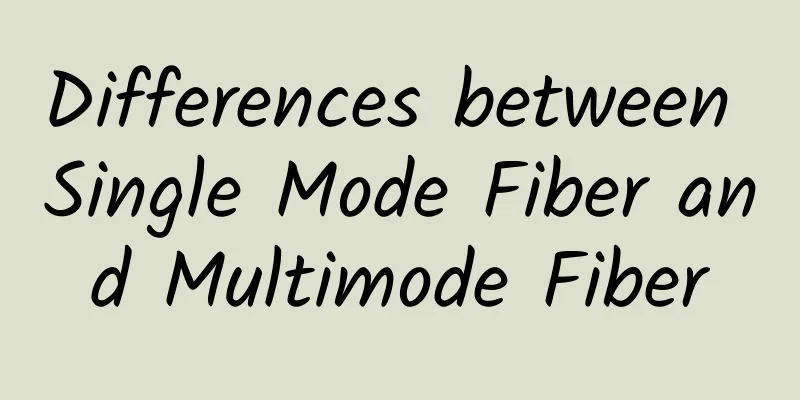Differences between Single Mode Fiber and Multimode Fiber

What is Fiber Optic?Fiber optics is a type of network cable that uses pulses of light to transmit data across an optical fiber. These fibers are usually made of glass or plastic. Fiber optics use metal wires, which are resistant to damage and immune to electromagnetic interference. This technology uses the total internal reflection of light. According to the propagation mode of light, there are two main types of optical fiber: single-mode fiber and multi-mode fiber. The former is often used for long-distance signal transmission, and the latter is often used for short-distance signal transmission. The difference between single-mode fiber and multimode fiberBoth types of optical fibers have their own properties and are used according to specific requirements, but there are clear differences between them. This article will shed light on the differences between single mode fiber and multimode fiber. Structural DifferencesAs the name suggests, single-mode fiber is used to transmit a single mode of light, while multimode fiber is used to transmit multiple modes of light simultaneously. But the difference between single-mode fiber and multimode fiber does not end there. Their construction is also very different. Single-mode fiber uses a 9µm optical core. This ultimately facilitates longer transmission distances and higher bandwidth. On the other hand, the optical core size of multimode fiber is 50µm. Bandwidth DifferenceIn terms of bandwidth, the two fiber types function differently. Single-mode fiber uses a strong light source, high brightness, and low attenuation. At the same time, it can provide unlimited bandwidth, making it the first choice in this fast-paced world. In contrast, multimode fiber can transmit multiple light modes. At the same time, the attenuation is greater and the brightness is lower. This is why the bandwidth is limited in multimode fiber. For users who prefer an uninterrupted experience, higher bandwidth is an obvious choice, so single-mode fiber has an advantage over multimode fiber in this regard. Distance DifferenceThe difference between single-mode fiber and multimode fiber | Smartpedia Distance in fiber optic cables refers to the transmission distance, which is determined by the electronics and their light output capabilities. Here, single-mode fiber emerged as a pioneer, capable of both short and long-distance transmission. At the same time, the transmission is not affected by the signal bandwidth or resolution quality. Most of them can be relayed up to 10 kilometers via single-mode fiber optic cables. In contrast, the maximum transmission distance of multimode fiber is between 300m-550m. This shorter distance is due to the cable classification of multimode fiber cables. Cost DifferenceNow, one of the most important determining factors in any buy/lease decision is price. In a cost-sensitive economy, it is always advantageous for businesses to choose the best priced option that works better. So far, single-mode fiber optic cables have a clear advantage over multimode fiber optic cables. Moreover, it is expected that the price will be higher due to the use of more powerful light sources and more complex optical processors. However, it would be misleading to assume that single-mode is more expensive than multimode fiber optic cables. Due to the high manufacturing efficiency, the price of single-mode fiber optic cables is lower than that of multimode fibers. To put the numbers into perspective, single-mode saves an average of 30% over multimode fibers. Application DifferencesThe essential differences between single-mode fiber and multimode fiber lead to differences in their applications. Single-mode fiber uses a 9µm core and transmits a single light mode. This allows single-mode fiber to maintain long-distance transmission. At the same time, this longer transmission range does not affect the bandwidth. Therefore, if long-distance transmission is required, single-mode fiber is more suitable than multimode fiber. On the other hand, due to the multiple light paths, multimode fiber optic cables are used in projects that require high bandwidth within a short distance. Types of Single-mode and Multimode FiberSingle-mode fiber and multimode fiber have different types based on wavelength, maximum attenuation, minimum overfilled modal bandwidth length and minimum effective modal bandwidth length. Multimode fiber is marked with OM and single-mode fiber is marked with OS. The following table lists the specifications of various types of single-mode fiber and multimode fiber: In summary, the differences between single-mode fiber and multimode fiber will play a role in the options available for any commercial project. Considering the pros and cons of both types, a project should analyze its needs and choose the right option. FAQQ: How far can single-mode optical fiber transmit?A: Due to the structure of single mode fiber, it can transmit 10 km or more without affecting the signal. This quality makes it ideal for any long distance transmission. Q: Can single-mode fiber work with multimode fiber?A: From a technical point of view, yes. Single-mode fiber can be used simultaneously with multimode. However, due to their different properties, the connection must be very short, the performance is inherently unpredictable, and it is very unreliable. Q: How do I know if an SFP is multimode?A: There are technical differences between single-mode and multi-mode SFPs, but to identify them at first glance, you should understand the color coding of the clips. Multi-mode SFPs are characterized by black clips. Q: Can single-mode fiber run 10G?A: Yes. Actually, both single-mode fiber and multimode fiber can run 10G. What needs to be considered is the distance required. For long-distance use, single-mode fiber is the ideal choice, while for short distances, multimode fiber can be selected. Q: How to distinguish single-mode fiber from multimode fiber?A: Optical fibers can be identified by the color coding of the clasps. Different types of single-mode optical fibers have the following colors, gray, purple, blue, green, yellow, orange, red, and brown. On the other hand, multimode optical fibers have black clasps. Q: How to distinguish single-mode fiber and multi-mode fiber patch cords?A: In addition to the color coding of the clips, you can also identify single-mode and multi-mode fibers by the color of the patch cords. In single-mode fibers, the patch cords are yellow; in multi-mode fibers, the patch cords are orange. Q: Can multimode fiber be used in single mode?A: Technically, you shouldn't do this, as it would result in a lot of optical losses. You can do the opposite, but it is not advisable to replace single-mode fiber with multimode fiber. Q: Can single-mode fiber be used with multimode SFP?A: Single-mode fiber and multi-mode fiber are very different in size, signal transmission, bandwidth, and light source. Therefore, it is not a good idea to use single-mode fiber with multi-mode SFP. |
<<: How can enterprises fully leverage the potential of private 5G networks?
Recommend
Summary of precautions and common problems in the use of twisted pair cables in weak current engineering
Twisted pair wire is the most commonly used trans...
Automation in SD-WAN and why you need WAN acceleration
Robert Sturt, general manager of streaming servic...
Are Paxos and Raft not consensus algorithms/protocols?
As a member of the Internet, we are often immerse...
Enabling Zero Trust Networking for Microservices with Istio Service Mesh
Translator | Li Rui Review | Chonglou 51CTO Reade...
SKB-enterprise: €2.39/month KVM-1GB/30GB/100M unlimited traffic/Netherlands (Amsterdam) data center
SKB-enterprise is a foreign hosting company found...
It feels so good to be validated!
Hello everyone, I am Xiaolin. Previously, I answe...
4 Ways to Save Money in Your Data Center
When data center downtime costs an average of nea...
Fortinet Named a Leader in Gartner® Magic Quadrant for Enterprise-Class Wired and Wireless LAN Infrastructure
Fortinet recently announced that it has been name...
iWebFusion: 1Gbps server starts at $49/month, 10Gbps server starts at $149/month
iWebFusion (or iWFHosting) is a foreign hosting c...
RAKsmart adds Japan cloud server with 30% discount, optional mainland optimization/premium network CN2+BGP, free snapshot backup
RAKsmart has launched its cloud server for about ...
Let’s talk about 5G dynamic spectrum sharing?
What is 4G/5G dynamic spectrum sharing? Why is 4G...
The ultimate solution to the problem that Github cannot display images
[[379338]] Preface Not long ago, I encountered th...
WiFi passwords are always cracked? Here are some tips to help you avoid WiFi hacks
With the development of mobile Internet technolog...
How the global 5G network will reshape future defense strategies
Explore the impact of global 5G networks on futur...
Seven trends revealing the future of mobile app development
【51CTO.com Quick Translation】 Undoubtedly, mobile...









